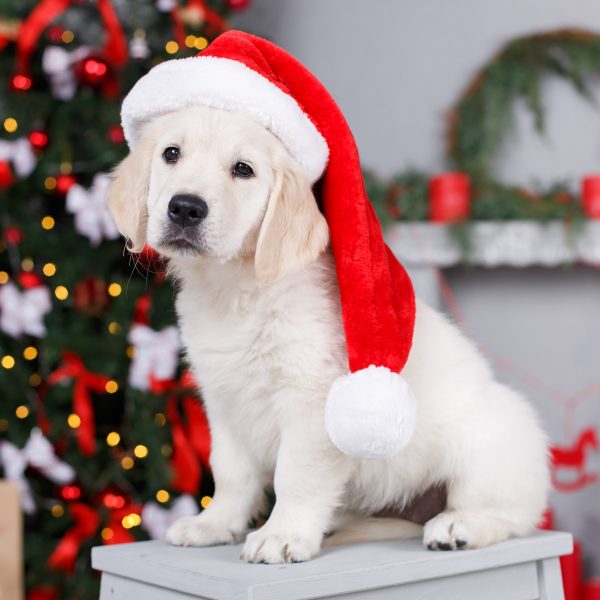3 Tips for Pet-Proofing Your Christmas Tree
 The holidays are often a time for food, family, and fun. They also tend to mean a lot of decorations and people, which can be huge distractions to your dog. There are plenty of stories about cats taking down Christmas trees. Dogs do it too and it can become harmful to them. Here are some tips for pet-proofing your Christmas tree:
The holidays are often a time for food, family, and fun. They also tend to mean a lot of decorations and people, which can be huge distractions to your dog. There are plenty of stories about cats taking down Christmas trees. Dogs do it too and it can become harmful to them. Here are some tips for pet-proofing your Christmas tree:
1. Secure the Tree
Trees that can tip or be knocked over are a dangerous accident waiting to happen. It may be funny when it happens in the movies, but it certainly is no laughing matter when it happens in real life. A fallen Christmas tree is heavy and can injure any dogs, or people, that get stuck underneath it. On top of that, there will likely be broken ornaments that cover the floor and become a danger to everyone in the room.
Whether you have an artificial tree or a real one, securing it is a good idea. Start with a high-quality, sturdy stand that will secure the base of the tree. Then, place the Christmas tree in the corner and anchor it to the ceiling and walls. Fishing line around the tree that is then tied to anchors in the wall and ceiling usually works well. Although this will add some extra steps when it comes to taking everything down, this will ensure that a curious animal can’t knock it down.
2. Get Your Dog Used to the Tree
A Christmas tree is likely only in your house for a short period of time each year. This means your dog has to get used to it every single year. In addition to securing the tree, leave it undecorated for a little bit. This will allow your dog to get used to the tree and will give you the opportunity to see how your dog reacts to it and interacts with it. Once you know what to expect and your dog is comfortable with the tree, then start decorating.
3. Keep Decorations Dog-Friendly
When you start putting up decorations, make sure you keep them dog-friendly.
Lights and Electric Cords
Lights may be beautiful, but the electric cords can be dangerous. Clumsy dogs can get tangled in the cords and curious chewers can be put at risk of a shock. If you want to use lights, it’s a good idea to start them higher up, leaving the bottom branches bare. Then, secure the cords that run from the tree to the wall.
These can be hidden underneath a decorative skirt or kept out of reach with adhesive cord clips. Also, candles may be popular decorations, but open flames and dogs do not go together. If you have to decorate with candles, stick with the LED ones. These are good pet fire safety tips to keep in mind for the holidays.
Ornaments
Broken ornaments and decorations are no one’s friend. If any decorations are fragile, put them towards the top of the tree. You can also switch to plastic ornaments as well. However, these should also be placed out of reach, especially if your dog is a chewer.
It’s also a good idea to avoid putting food-based decorations on the tree. Depending on the size of your dog, and their excitement level, you may want to consider leaving the bottom of the tree undecorated.
Food and Plants
Most importantly, keep toxic foods and plants out of sight and out of reach of your dog. Chocolate is a popular Christmas treat for humans, but it is toxic to dogs. It may be common to have candy out during the holidays, especially if you have guests. However, it’s best to keep this limited and out of reach of any curious pups.
Mistletoe, poinsettias, and holly are popular plants for the holidays, but these are potentially toxic to dogs. Although you can put these out of reach of your dog, it’s safest to forgo using them entirely or use artificial versions instead. If you have a natural Christmas tree, be sure to sweep up fallen pine needles every day, or multiple times a day if needed. Pine needles may not be toxic to your dog, but they are sharp and small enough to ingest. If your dog tries to eat them, they can become lodged in your dog’s mouth or intestines, causing blockages or injury.
It may also be a good idea to save the presents for Christmas morning instead of leaving them under the tree. It might not be an issue with your dog, but there are certainly plenty of stories about dogs eating a present or two when they were left under the tree. In order to keep your dog, and your presents, safe, store them somewhere else and then bring them out Christmas morning. If you don’t know what’s inside the presents, this will also keep your dog from ingesting anything potentially dangerous or toxic that you didn’t realize was there.
The holidays truly are a time for family. If yours happens to include a furry, four-legged friend, these tips will help keep your dog safe during the holidays.
